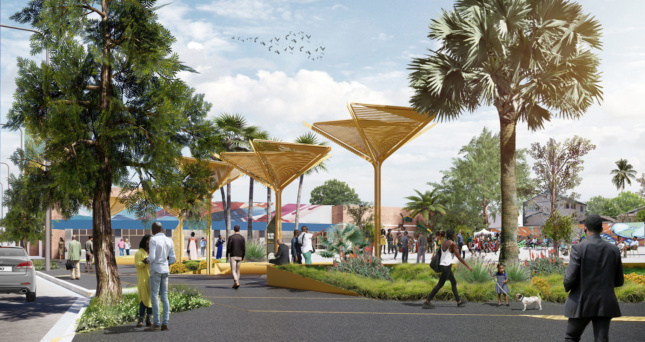For the city of Crenshaw, a historically black neighborhood in Los Angeles County, the initial symptoms of gentrification are beginning to make themselves present. Businesses and shops are closing down after decades of serving the community, the cost of housing is suspiciously skyrocketing while shops and cafes with variously esoteric titles are popping up along its main thoroughfares. “Gentrification is a crisis that threatens all elements of the work that we do,” said Damien Goodmon, executive director of the Crenshaw Subway Coalition. It’s a workers issue. It’s a public health issue. It’s an education issue. It’s an environment issue. It’s a civil rights issue.”
A 1.3-mile-long open-air museum along Crenshaw Boulevard, set to be completed by spring of next year, was designed to combat ensuing gentrification by empowering the community that has called the neighborhood homes for several decades. Titled Destination Crenshaw, the project was spearheaded by L.A. City Councilmember Marqueece Harris-Dawson and designed by architecture firm Perkins+Will, the same studio behind similarly-motivated projects, including Charlotte’s Harvey B. Gantt Center for African-American Arts + Culture and Washington DC’s National Museum of African American History. “Unlike traditional museums,” writes Perkins+Will, “Destination Crenshaw won’t be bound by walls or ceilings. The open-air, public art and cultural experience will feature architectural designs that capture the innovative and trailblazing spirit of Black L.A.”
Destination Crenshaw was primarily devised as a pedestrian-friendly zone, complete with monuments, art, park space, and viewing platforms, and will also preserve and integrate the Crenshaw Wall, an 800-foot mural depicting images and icons from black history, painted by graffiti collective Rocking the Nation, into its overall design. However, the project is also designed to be visible from the Crenshaw/Los Angeles Airport (LAX) Metro Rail Line, an 8.5-mile-long light-rail system also set to be complete by spring of next year. “We really wanted to look at how we [can] use the opportunity that the rail presents to solidify, to restore the historic African American community in Southern California,” said Harris-Dawson, “and doing it in a way that benefits the people who already live there.”

Beyond its ability to tell the history of the storied neighborhood through the employment of local artists, Harris-Dawson also hopes Destination Crenshaw will become a catalyst for bringing back businesses operated by members of the local creative community as well as boost the region’s economy. The goals laid out by the project inspired Perkins+Will to reimagine how a museum can enhance a neighborhood. “What was clear was being able to tell a very large story about this community being there for so long and also the contribution of all the major players and heroes that have come out of that community,” said Zena Howard, the lead architect at Perkins+Will. “We began thinking about how you could tell the story not in a chronological way, not like a history museum, not in a didactic way, but more in an experiential way.”
While many see the project as a boon for the neighborhood, others are slower to consider it under such absolute terms. Earl Ofari Hutchinson, a longtime resident of Crenshaw and the president of the Los Angeles Urban Policy Roundtable, maintains that it is “unrealistic at best and a delusion at worst” to believe that Destination Crenshaw will halt the gentrification already present in the neighborhood.











